| | Overview
American grass and legume seed exports continue to rise, in both quantity and value of exports. Grass and legume seed exports for the July 2012 to June 2013 crop year saw total grass and legume seed exports reach 458 million lbs., up minimal compared to the previous year, but still the highest amount ever. Despite the quantity of seed exported rising only by 4 million lbs. from 2011/2012, a 1.5% increase, the value of the seed exported increased by over 9%. The total value of US grass and legume seed exports reached close to $410 million. Of the total lbs. of grass and legume seed exported, “grass seeds” consisted of 388,000,000 lbs (84.8%), with “other forage seeds” making up the other 69,500,000 lbs.
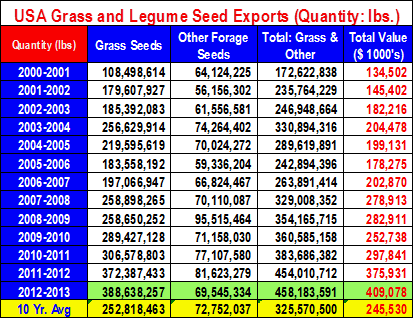
Destination
When broken out by world geographic regions, a large portion of US exports are destined to East Asia, with the majority of this seed being annual ryegrass, tall fescue and grass seed mixtures. The EU 28 and Mexico/Canada (North America) regions follow with over 90 million lbs of seed being exported here. After these 3 world regions, exports fall off dramatically.
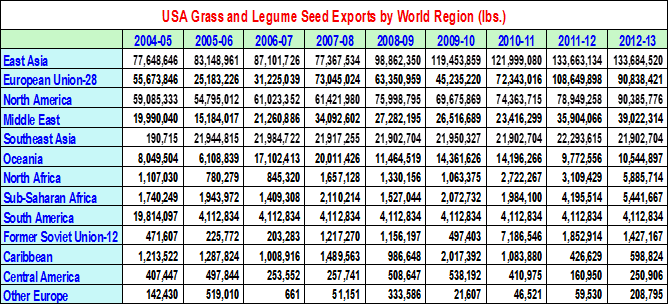
USA Exports by Species
In terms of volume, annual ryegrass continues to be the number one exported grass seed out of the USA. 2012/13 saw over 117 million lbs. exported world worldwide, well above the10 year average of 59.7 million lbs. No other species comes close to this export number as the next most exported species, perennial ryegrass “only” saw exports reach 41 million lbs. Alfalfa seed and tall fescue seed exports were at 40 and 37.6 million lbs. respectively. However, in terms of value, the “queen of the legumes”, alfalfa, continues to lead the way, with total export value at $114 million. Total annual ryegrass export value, despite such huge quantities being exported, only came in at $45.6 million. The value of the exported perennial ryegrass and tall fescue came in at $32.8 and $29 million respectively. However, the exports of grass seed mixtures accounted for 44.5 million lbs. of exports, with a value of $49.0 million. What grasses are in these mixtures is not broken out. Of interest to our Canadian growers is the amount of creeping red fescue and red clover exports, which were at 12.5 million and 4.2 million lbs. respectively.
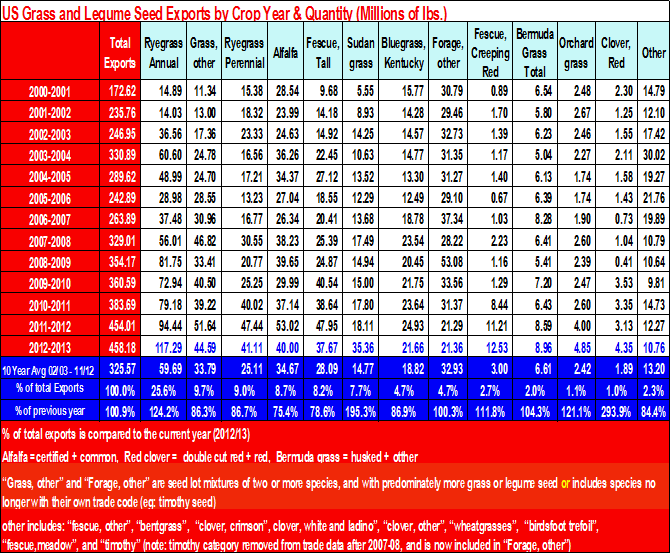
Who's Buying?
When looking at individual countries (exception = Middle East), the USA’s major trade partners in grass and legume seed trade are listed below. China, followed by Canada, the Middle East, Japan, Italy, and Mexico, all imported over 25 million lbs. of seed from the USA.
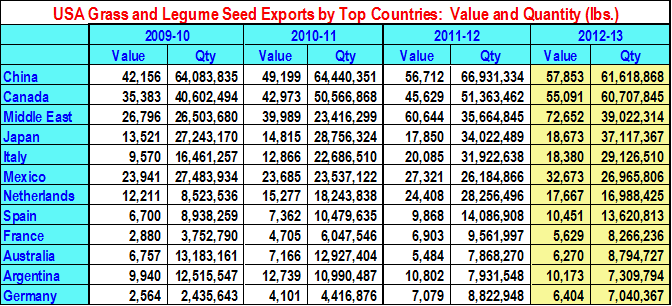
China
2012/13 USA trade data shows China as the USA’s top trade partner, with Canada holding down the second largest destination for USA grass and legume seed exports.
China’s 61.6 million lbs. of American grass and legume seed imports was dominated by annual ryegrass (19.4 million lbs.) and tall fescue (11.9 million lbs.). “Grass Seed, other” mixtures ranked 3rd, with 11.7 million lbs. being imported. Annual ryegrass seed imports increased by 7.6 million lbs. from the previous year, but tall fescue imports fell by 6.4 million lbs. Perennial ryegrass imports remained steady, with 6.7 million lbs. imported from the USA in 12/13.
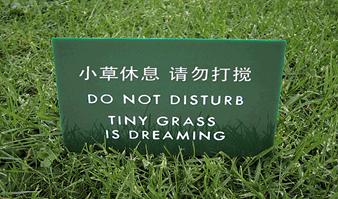 | Alfalfa seed imports from the USA are once again rising, with 1.7 million lbs. imported, up 450,000 lbs. from last year. Chinese alfalfa seed imports from the USA was a meager 67,000 lbs only 3 years pervious. However, this year’s certified alfalfa imports only accounted for 5% of her total alfalfa seed imports. For the 2nd consecutive year, imports of Kentucky bluegrass seed fell. 2010/11 saw 9.3 million lbs imported, which fell to 7.7 million lbs. in 2011/12, and data |
shows imports down to 5.2 million lbs. this past crop year. After a spike to almost 4 million lbs. in 2011/12, Bermuda grass seed imports retreated to just under 3 million lbs. last year. Prior to 2011/12, Bermuda grass seed exports were at 2.7 and 2.6 million lbs. the previous two years.
In total, 2012/13 saw China import $57.8 million worth of grass and legume seed from the USA. Grass seed mixtures/unspecified trade species made up the largest amount at $13.6 million. Although it made up the largest imported crop by quantity (annual ryegrass seed), the average export price of the seed was only 35.4¢ / lb., much less than the export value of tall fescue (81.2¢ / lb.) or perennial ryegrass seed (83.8¢ / lb.).
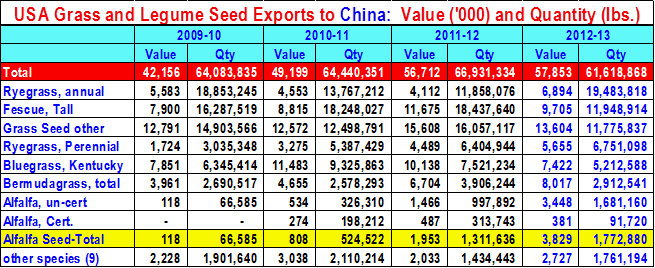
Canada
Exports of grass and legume seed to Canada is dominated by turf grass seed, specifically perennial ryegrass, Kentucky bluegrass, and creeping red fescue. However, this creeping red fescue export number, (11.3 million lbs.) may be misleading, as annual USA creeping red fescue production in only around 8 to 10 million lbs. Therefore, a lot of cross border trade occurs between Canada (one of the worlds’ largest creeping red fescue producers) and the USA, with subsequent Canadian “Creeper” exports re-marketed/re-packaged and sold back into Eastern Canada. Another explanation could be off-shore creeping red fescue imported into the USA, then exported into Canada after processing. A third explanation could be mislabelling of other USA grown fescues’ as creeping red. The same is probably true for perennial ryegrass seed, as Canada is a net exporter of this grass seed. Therefore, Canada’s ranking as the USA’s second largest grass and legume seed importer may be misleading.
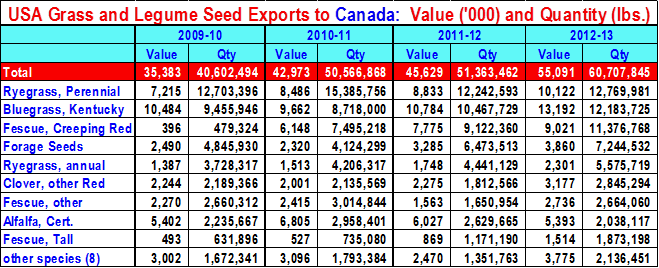
Middle East (Saudi Arabia)
When looking at the Middle East as one region, this would make it the 3rd largest single destination for American grass and legume seed. (39 million lbs.). The primary buyer in the region is Saudi Arabia, who buys over 30 million lbs of this total, consisting primarily of alfalfa seed (13.3 million lbs.) and sudangrass seed (15.8 million lbs.). In this region, Turkey is the only other country of significance, buying over 1 million lbs. each of tall fescue, perennial ryegrass and grass seed mixtures.
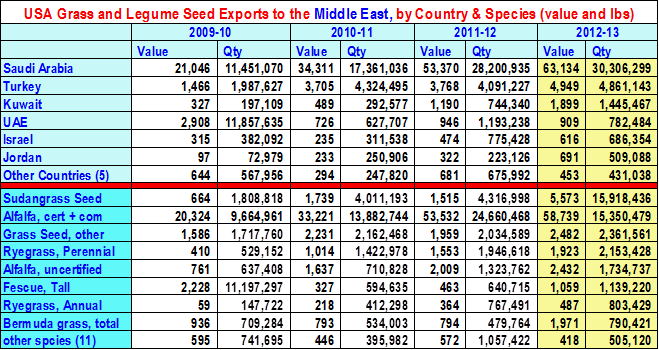
Japan
| Japanese grass and legume seed imports continue to rise, with annual ryegrass making up the largest grass/legume seed being imported (22.5 million lbs., 60.8%). Grass seed mixtures amounting to over 5 million lbs followed, with Sudan grass holding down 3rd place (3.3 million lbs.) Japanese imports of USA seed continues to grow, up by over 10 million lbs. from 3 years ago. In total, over $18 million worth of grass/legume seed was imported from the USA. | 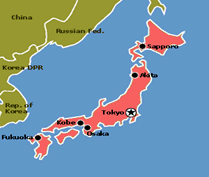
|
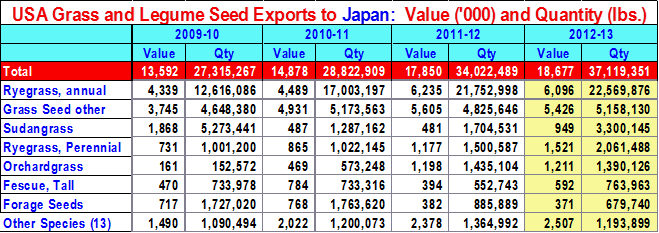
Italy
Italy continues to be the EU 28’s largest imported of American grass and legume seed. Imports are dominated by annual ryegrass seed (16 million lbs.), followed by Sudangrass seed (4.4 million lbs.). After increasing imports from 09-10 to 2011/12, import amounts have steadied around 30 million lbs. the past two years.
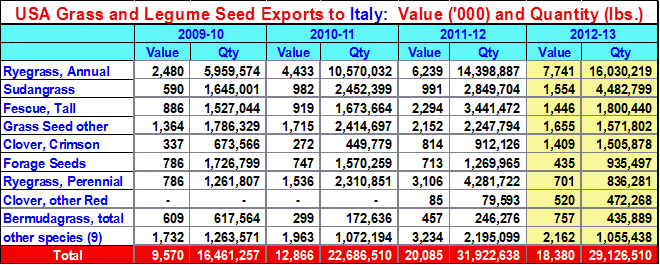
Mexico
| Exports of American grass and legume seed to Mexico continues to be dominated by forage varieties, mainly alfalfa and “grass seed, other” (mixtures). Both show imports by Mexico of over 9 million lbs., consistent with the past few years. The value of seed from the USA continues to grow, with 2012/13 showing over $32 in imports. | 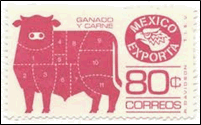 |
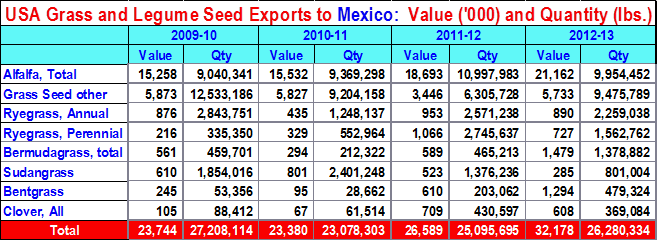
Other Top Importing Nations
| 4 of the next 6 importers of US grass and legume seed are from the EU. These 4 countries account for over half of the EU’s total imports. All 4 countries imported over 1 million lbs. of perennial ryegrass, while 3 of these countries imported over 1.5 million lbs. each of annual ryegrass. Tall fescue also saw at least 1 million lbs. imported into all 4 countries. The Netherlands imported over 5.7 million lbs. of “grass seed, other”, while Spain imported 2.4 million lbs. Australia, ranking 10th overall as a destination for US seed, saw its major imported species being annual ryegrass (4.9 million lbs.), accounting for well over 50% of its grass and legume seed imports from the USA. Argentina, with its expanding livestock base, saw imports of alfalfa over 1.7 million lbs | 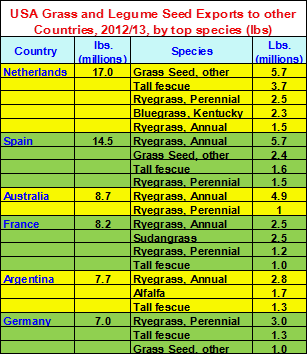 |
Summary
The world financial crisis which began in 2008 affected all aspects of the worlds’ various economic sectors, agriculture included. The USA grass and legume seed market was especially affected, with the housing market, which makes up the majority of USA grass seed consumption, hit hard. However, as the laws of supply demand has shown, this “supply glut” of unused American seed become in demand, once prices move down to reflect the oversupply. American grass and legume seed exports have increased to meet this increase in demand, brought on not only by lower prices, but by the continual increase in world demand as the world comes out of this crisis.
Now, with increased prices for other agricultural commodities resulting in better returns, supply going forward may become tighter in the grass and legume seed sector, as less land becomes dedicated to grass and legume seed production. Lower prices has helped move excess inventories, but with demand now greater, production will have to ramp up to meet not only the increased USA domestic usage, but overseas demand. The USA remains the world’s number one supplier of grass and legume seed.
Note: due to conversions, some numbers may be slightly off. Trade data does not account for secondary processing and possible re-exporting to other countries after original seed amounts have been imported into a particular country, nor does the data account for possible incorrect entries by exporting companies. Trade data obtained from Foreign Agriculture Service (FAS), USDA.
Prepared by David Wong, Market Specialist, Alberta Agriculture & Rural Development, Ag-Info Centre 310-3276
|
|